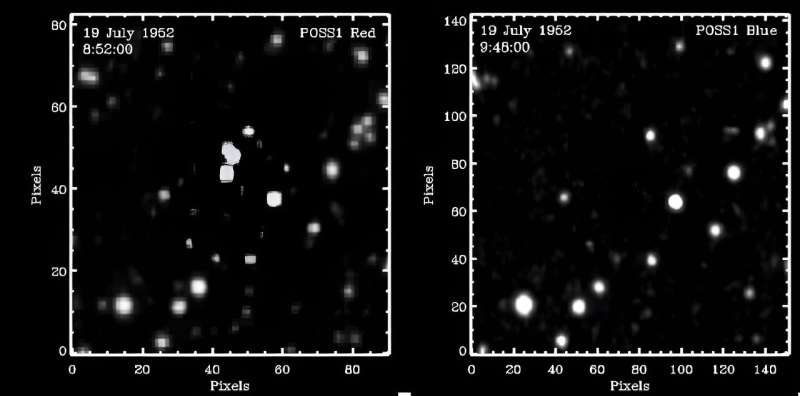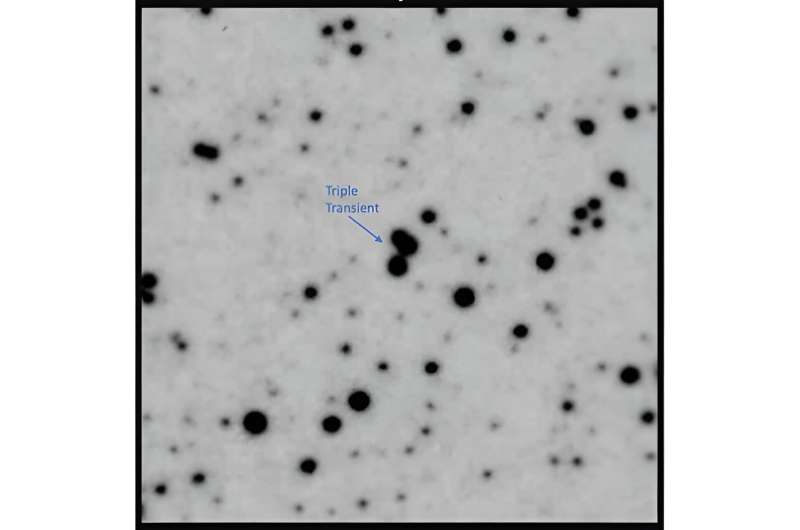This article has been reviewed according to Science X's editorial process and policies. Editors have highlighted the following attributes while ensuring the content's credibility:
fact-checked
preprint
trusted source
proofread
In 1952, a group of three 'stars' vanished—astronomers still can't find them

On July 19, 1952, Palomar Observatory was undertaking a photographic survey of the night sky. Part of the project was to take multiple images of the same region of sky, to help identify things such as asteroids. At around 8:52 that evening a photographic plate captured the light of three stars clustered together. At a magnitude of 15, they were reasonably bright in the image. At 9:45 pm the same region of sky was captured again, but this time the three stars were nowhere to be seen. In less than an hour they had completely vanished.
Stars don't just vanish. They can explode, or experience a brief period of brightness, but they don't vanish. And yet, the photographic proof was there. The three stars are clearly in the first image, and clearly not in the second. The assumption then is that they must have suddenly dimmed, but even that is hard to accept.
Later observations found no evidence of the stars to dimmer than magnitude 24. This means they likely dimmed by a factor of 10,000 or more. What could possibly cause the stars to dim by such an astounding amount so quickly?
One idea is that they are not three stars, but one. Perhaps a star happened to brighten for a short time, such as a fast radio burst from a magnetar. While this happened, perhaps a stellar-mass black hole passed between it and us, causing the flare to gravitationally lens as three images for a brief time.
The problem with this idea is that such an event would be exceedingly rare, but other photographic images taken during the 1950s show similar rapid disappearances of multiple stars. In some cases, the stars are separated by minutes of arc, which would be difficult to produce by gravitational lensing.

Another idea is that they weren't stars at all. The three bright points are within 10 arcseconds of each other. If they were three individual objects, then something must have triggered their brightening. Given the timespan of about 50 minutes, causality and the speed of light would require they were no more than 6 AU apart.
This means they would have to be no more than 2 light-years away. They could have been Oort Cloud objects where some event caused them to brighten around the same time. Later observations couldn't find them because they had since drifted on along their orbits.
A third idea is that they weren't objects at all. Palomar Observatory isn't too far from the New Mexico deserts where nuclear weapons testing occurred. Radioactive dust from the tests could have contaminated the photographic plates, creating bright spots on some images and not others. Given similar vanishings seen on other photographic plates of the 1950s, this seems quite possible.
At this point, we can't be sure. What we really need is to capture a few of these events in modern sky surveys, where we can quickly go back and make additional observations. For now, it's a mystery waiting to be solved.
Related research is published on the arXiv preprint server.
More information: Enrique Solano et al, A bright triple transient that vanished within 50 minutes, arXiv (2023). DOI: 10.48550/arxiv.2310.09035
Journal information: arXiv
Provided by Universe Today




















